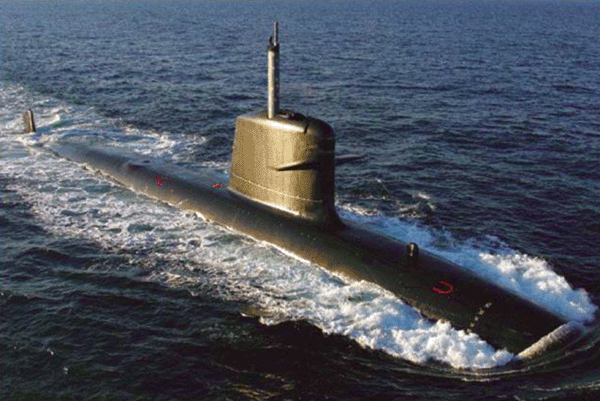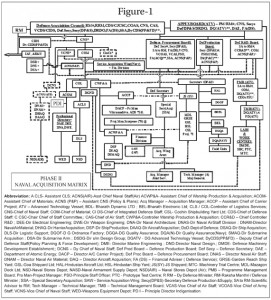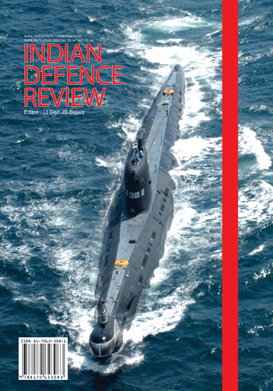The achievements of its work centre, the Defence Machinery Development Establishment (DMDE) would be an eye opener. It would be well worth the while for the IN to study this model and incorporate the same in its indigenisation programme including establishing a DMDE clone. Other work centres have also performed equally well.
The IN has adequately proved its credentials with regard to its commitment to indigenisation. To effectively and efficiently exploit the indigenous potential further, there is a need for a mindset change within the IN and particularly in the Ministry of Defence (MoD). The entire Higher Defence Management (HDM) organisational structure needs to be re-oriented on a functional basis – similar to the global practice. The recommended organisation structure to fulfil such a requirement with specific reference to the IN is illustrated at Figure-1.12,13 This, in principle, is also in conformity with an objective set in the Kelkar Committee report. It recommended the restructuring of the acquisition wing of the MoD along the lines of Direction Generale de L’armament (DGA) – the French defence procurement organisation.
INS Arihant going critical on August 10, 201314 gave further impetus and confidence to the competence level of the ATV model. The model clearly demonstrates how a professional autonomous body, devoid of any conventional bureaucratic baggage, can deliver such a complex object, as a nuclear submarine. The core content of the organisational model would need to be adapted and incorporated in the restructuring process recommended.
At this point of time, a legitimate question being asked is as to where India stands on giving priority to building indigenous submarine design capability. It would seem that we are once again seriously considering going in for a Joint Venture (JV) production agreement for the Project 75I. The need for building up of the submarine force level at an accelerated pace is strategically unquestionable. It is reported that the IN has reconciled itself to living with the situation and manage the interim by modernising the existing boats.15 With the dismal record of HSL in undertaking Medium Repairs (MR) of one 877EKM boat, presumably, all the modernisation of the remaining 877EKM boats would be offloaded to Russia, as hitherto.
Where does India stands on giving priority to building indigenous submarine design capability?
The tragic loss of INS Sindhurakshak is a serious body blow to the IN pushing the submarine ORBAT level below acceptable norms. At the same time, the issue of acquiring indigenous submarine design capability is an equally compelling strategic technological objective and forms part of the approved thirty-year submarine capability building exercise.
Conclusion
In the above circumstances, it is suggested that in the debate leading to the evolution of the strategy for formulating the Request for Proposal (RFP) for Project 75I and finalising the JV Agreement, the following overriding criteria should be seriously considered and conflicting interests duly resolved. Such an opportunity is rare and India must not miss the boat again:
- The urgency of filling up the fast depleting submarine force levels.
- The strategic necessity for establishing an alternative construction site on the East coast of India.
- The strategic technological compulsions of acquiring an autonomous submarine design capability.
- Since the ATV programme has attained reasonable confidence in design capability in respect of a nuclear powered submarine with double-hull configuration, priority be accorded to acquire single-hull design capability also.
- Make a professional and pragmatic judgement regarding choice between the two categories i.e. single hull/double hull that would optimally meet the Navy’s operational requirement.
- Taking into account India’s past experience with licenced production of HDW type 1500 SSK submarine and DCNS Scorpene submarine, ensure that no compromise is made on the issue of TOT on design know-how and know-why. A conscious and determined decision may be taken to ensure that this opportunity is not allowed to slip out of hand.
- For achieving India’s indigenisation goals, the proposed RFP should incorporate the requirement of using the Indian pressure hull steel on 75I submarine. This should be introduced at least commencing with those submarine proposed to be built in the new shipyard. Indian designers must be fully involved with the design/professional assessment of the implications and if called for, with any process of consequential redesigning work. With one stroke of the pen, incorporation of such a provision in the Agreement would, on its own, provide on a platter an estimated 15 to 20 per cent indigenous component to the overall cost of the boat.
- Expeditiously cloning ATV’s DMDE model and going piggy-back on all the indigenous vendors that the ATV project has painstakingly developed, could be a bonanza on the indigenisation front.
- If necessary, negotiate a separate comprehensive Government-to-Government Protocol intrinsically linked to the main Agreement-/Contract. The leverage that India has at this stage of negotiation should not be squandered. Such an opportunity will not repeat itself. All loose ends must be clearly resolved including:
i. Access to design software, linked empirical formulae/design coefficient and a comprehensive catalogue of submarine component data along with global vendor particulars in the NATO Codification System (NCS) format.
ii. Full joint design collaboration with the parent Design Bureau including systems design, design validation at all stages and in all disciplines, model hydro-dynamic/acoustic/shock/vibration testing.
iii. Whether these are achieved under the offsets clause or otherwise, is a matter of detail.
iv. Need for raising the FDI cap under the ToT on cutting edge technology clause.
It is most unlikely that the desired extent of cooperation would be forthcoming from any submarine industrial base enshrined within a capitalist economy. In the case of France, both the Defence Minister and the Ambassador, on separate occasions, have indicated their limitations in agreeing to part with submarine design know-how and know why to India.16,17 The signals from USA are not much different.19
It is most unlikely that the desired extent of cooperation would be forthcoming from any submarine industrial base enshrined within a capitalist economy…
- To meet the immediate shortfall in submarine ORBAT status following out-of-the box options could be considered. These, however seem to have already been discounted18.
i. Suitable lease arrangement from friendly countries.
ii. Outright off-the-shelf purchase of submarine.
iii. Offloading additional submarine supply from OEM shipyards.
- Over and above, all the options discussed earlier, in case the negotiations fail to achieve the break through expected from the Western sources, India should not then hesitate in taking up a joint submarine design collaboration agreement as an adjunct to the production contract with a Russian shipyard-cum-design bureau consortium. This would carry forward our proven valuable experience and confidence levels already built up in the sister ATV programme. If in the Indian context, the single hull configuration has an overwhelming operational advantage, even that could be accommodated in the Russian collaboration option. Adapting such a route would also have the additional advantage of furthering our indigenisation goals by being able to use without great difficulty, the submarine pressure hull steel already developed and cleared for use on Indian SSBNs. Large numbers of Indian vendors meticulously nurtured under the ATV Programme could be usefully harnessed to meet the requirements of 75I and follow-on project.
- When selecting the second production line for 75I submarine, due consideration could be given to private sector shipyards also. Taking into account the serious limitations that the IN would have in creating and retaining the required large additional design cadre personnel, due consideration be given to offloading most of the design functions to private partners. L&T, for example, has established credibility in this field in the ATV programme. The IN could retain the responsibility of formulating the concept design and offload the tasks of Preliminary, Detail design and Production/working drawings under a PPP arrangement. All these must be seriously considered and incorporated at the RFP stage and concluded as an adjunct and intrinsic to the 75I Agreement.
- Also, extract the maximum from Navy’s long-standing warm relationship with the Russian Design Bureau Neptune and Krylov Design Institute. This has been further strengthened by the technical cooperation agreement struck between the National Institute of Research and Development in Defence Ship-Building (NIRDESH) at Chinliyan near Calicut and the Krylov Institute.
Notes
1. A.P Revi, “India’s Indigenous Submarine – The Design Dilemma”, Indian Defence Review, Vol. 27(3), July-Sept 2012, p. 52.
2. Revi, “Arihant, The Annihilator,” Indian Defence Review, Vol. 24(4) Oct-Dec 2009, p. 45.
3. TNN; 25 Jan 2002. <article-timesofindia.indiatimes.com/2002-01025/Mumbai/27117786_1_aircraftcarrier-ins-vikrant-indian-navy>
4. V.Adm R.N Ganesh, “Future Tense, S/M As A Potential Instrument Of Sea Power,” Indian Defence Review, V. 20(3)
5. Cmde Ranjit Rai, “Indian Navy’s Second Submarine Line Will Witness Strong Competition”, Indian Strategic, www.freepublic.com/focus/fnews/2720209/post.
6. John F Sehank and Co, Sustaining US Nuclear s/m Design Capability. RAND Report. National Defence Research Institute USA. Figures 3.6 and 3.7.
7. Ibid, p. 15.
8. RAND Report: www.rand.org/pubs/research_briefs/RB9562.html.
9. John Birker, Industry & Infrastructure for Future s/m: An International Perspective Speech presented at the s/m Institute of Australia’s Biennial Conference in Perth, Nov 2010. www.rand.org/pubs/corporate_pubs/CP622.html. Some of the suggested actions for Australia are already part of India’s ATV Programme.
10. Laksman Kumar Behra, Indian Defence Industry – Issue of Self Reliance, IDSA Monograph series 21, July 2013.
11. S.N Misra, Ship Building, India Strategic. www.indiastrategic.in/topstories1157_Ship_Building_and_India.html.
12. Revi ‘Restructuring India’s Military – Out of Box Option’. Figures 5.3 & 6.46. Chapter 5, 6 and 10. Gyan Publishing House, New Delhi. June 2012.
13. A.P Revi, Faultlines in Civil Military Framework: in India & Way Forward, Defence Studies, London, Vol. 14 Issue 2, June 2014. pp. 134–160.
14. T.S Subramaniam Critical Feat. Front Line 06 September 2013.
15. Rajat Pandit ‘Navy Drops Call for Foreign Subs After Project Delayed’. TOI 08 September 2014.
16. Francois Richier the French Ambassador to India. During an interactive session after his address to the Observer Research Foundation, New Delhi on ‘What Makes the Indo-French Relation Special – Understanding the Dynamics of Strategic Partnership’, 11 Feb 2013.
17. Jean Yves Le Drian – the French Defence Minister at an interactive session after a lecture at the IDSA on Indo-French Partnership: The Choice of Strategic Autonomy, 22 July 2013.
18. Joint Statement at the end of the Indo-US Strategic Dialogue of 24 June 2013 are not encouraging in respect of any possibility of going beyond coproduction. www.security-risks.com/security-trend-south-asia/india-defence/india-us-defence-cooperation:-impetus-instrategic-1979.html
19. Serial 14 Ibid.







